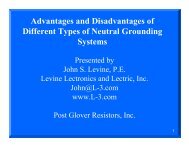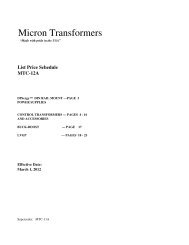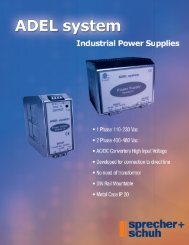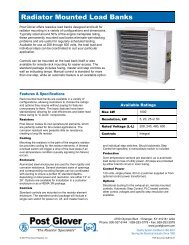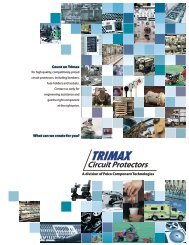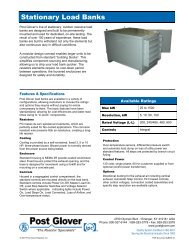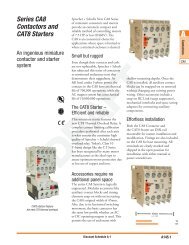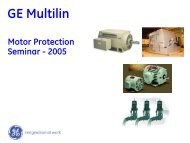The 2008 Revision of IEEE C37.2 Standard Electrical Power System ...
The 2008 Revision of IEEE C37.2 Standard Electrical Power System ...
The 2008 Revision of IEEE C37.2 Standard Electrical Power System ...
Create successful ePaper yourself
Turn your PDF publications into a flip-book with our unique Google optimized e-Paper software.
• SER - Sequence <strong>of</strong> Events Recorder.<br />
As the work continued, the WG ultimately added twelve more acronyms for new functions not<br />
previously defined in <strong>C37.2</strong>, for a total <strong>of</strong> seventeen. Note that these are functions that may reside<br />
in a single function device, or as one <strong>of</strong> several in a Device 11 multifunction device.<br />
Here are all <strong>of</strong> the familiar and new acronyms with descriptions that appear in <strong>C37.2</strong>-<strong>2008</strong>. Notes in<br />
italics give information not appearing in <strong>C37.2</strong> itself:<br />
• AFD – arc flash detector - A device / function that detects an unintentional electrical arc in<br />
air. (Arc flash detection in metal clad switchgear has been a frequently discussed topic at<br />
the present conference in recent years. AFD is the sensing function that may be a part <strong>of</strong> a<br />
Device 11 multifunction protective relay for a zone within the switchgear.)<br />
• CLK – clock or timing source - A device/function that receives an accurate timing signal<br />
input and distributes an accurate timing signal output to other devices. Note: An example <strong>of</strong><br />
an accurate timing signal input is a signal received from a GPS (Global Positioning <strong>System</strong>)<br />
satellite clock. An example <strong>of</strong> an accurate timing output signal is IRIG-B (Inter-Range<br />
Instrumentation Group Type B).<br />
• DDR – dynamic disturbance recorder - A device/function that records incidents that portray<br />
power system behavior during low frequency (0.1 to 3 Hz) oscillations, and abnormal<br />
frequency or voltage excursions. (Definition from the Southeast Electric Reliability<br />
Council.)<br />
• DFR – digital fault recorder - A device/function that records, for analysis purposes, events<br />
on the power system. It records voltage and/or current waveforms replicating the primary<br />
power system voltages and currents when triggered by a sudden change in the waveforms or<br />
by an external event.<br />
• ENV – environmental data - A device/function that measures and stores variables relating to<br />
the environment, such as weather data, ice buildup conditions, geomagnetic disturbances,<br />
earthquakes, and other similar phenomena.<br />
• HIZ – high impedance fault detector - A device / function that detects high impedance faults<br />
on grounded or ungrounded systems.<br />
• HMI –human machine interface - A device/function that displays data/information to and<br />
allows control <strong>of</strong> a system by an operator. A HMI may also be local to a specific device for<br />
operator interaction specific to that device.<br />
• HST – historian - A device/function that continuously gathers states and values from a data<br />
concentrator or directly from protection and control IEDs (Intelligent Electronic Devices),<br />
and may also act as a recorder <strong>of</strong> data from which trends may be determined.<br />
• LGC – scheme logic (the function, as in a RAS– not a device like a PLC) – A<br />
device/function that provides the programmed logic for a multi-device control/protective<br />
relay scheme, such as a Remedial Action Scheme (RAS) or an interlocking scheme.<br />
• MET – substation metering - A device/function that is connected to CTs and VTs, and may



